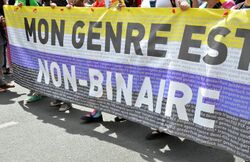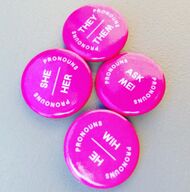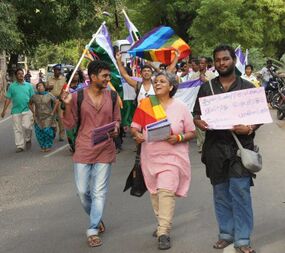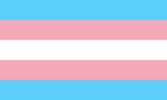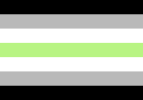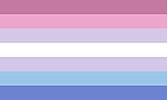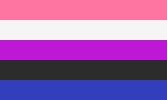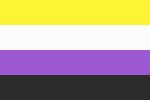History:Non-binary gender
Template:Infobox gender and sexual identity Non-binary[lower-alpha 1] or genderqueer is an umbrella term for gender identities that are neither male nor female—identities that are outside the gender binary.[2][3] Non-binary identities fall under the transgender umbrella, since non-binary people typically identify with a gender that is different from their assigned sex,[3] though some non-binary individuals do not consider themselves transgender.[4]
Non-binary people may identify as an intermediate or separate third gender,[5] identify with more than one gender,[6][7] no gender (agender), or have a fluctuating gender identity (genderfluid).[8] Gender identity is separate from sexual or romantic orientation,[9] and non-binary people have a variety of sexual orientations, just as cisgender people do.[10]
Non-binary people as a group vary in their gender expressions, and some may reject gender "identities" altogether.[11] Some non-binary people are medically treated for gender dysphoria with surgery or hormones, as trans men and trans women often are.
Definitions and identity
The term genderqueer originated in queer zines of the 1980s as a precursor to the term non-binary.[12] In addition to being an umbrella term, genderqueer has been used as an adjective to refer to any people who are perceived to transcend or divert from traditional distinctions of gender, regardless of their self-defined gender identity. Individuals may express gender non-normatively by not conforming into the binary gender categories of "man" and "woman".[13] Genderqueer is often used to self-identify by people who challenge binary social constructions of gender.[14][page needed]
The term genderqueer has also been applied by those describing what they see as a gender ambiguity.[15][page needed] Androgynous (also androgyne) is frequently used as a descriptive term for people in this category. This is because the term androgyny is closely associated with a blend of socially defined masculine and feminine traits.[16][page needed]However, not all genderqueer people identify as androgynous. Some genderqueer people identify as a masculine woman or a feminine man or combine genderqueer with another gender option.[17] Being non-binary is not the same as being intersex, and most intersex people identify as either male or female.[18] Some people use enby (from the letters 'NB') as a short form of non-binary.[19][20]
Many references use the term transgender to include genderqueer/non-binary people.[11][21][22] The Human Rights Campaign Foundation and Gender Spectrum use the term gender-expansive to convey "a wider, more flexible range of gender identity and/or expression than typically associated with the binary gender system".[23]
Agender people ('a-' meaning "without"), also called genderless, gender-free, non-gendered, or ungendered,[24][25] are those who identify as having no gender or being without a gender identity.[26][27][28] Although this category includes a broad range of identities which do not conform to traditional gender norms, scholar Finn Enke states that people who identify with any of these positions may not necessarily self-identify as transgender.[29] Agender people have no specific set of pronouns; singular they is typically used, but it is not the default.[30] Neutrois and agender were two of 50 available custom genders on Facebook, which were added on 13 February 2014.[31] Agender is also available as a gender option on OkCupid since 17 November 2014.[32]
Bigender (also bi-gender or dual gender) people have two gender identities and behaviors. Identifying as bigender is typically understood to mean that one identifies as both male and female or moves between masculine gender expression and feminine gender expression, having two distinct gender identities simultaneously or fluctuating between them.[33][34][35] This is different from identifying as genderfluid, as those who identify as genderfluid may not go back and forth between any fixed gender identities and may experience an entire range or spectrum of identities over time.[36][37] The American Psychological Association describes the bigender identity as part of the umbrella of transgender identities.[38] Some bigender individuals express two distinct personas, which may be feminine, masculine, agender, androgyne, or other gender identities; others find that they identify as two genders simultaneously. A 1999 survey conducted by the San Francisco Department of Public Health observed that, among the transgender community, 3% of those who were assigned male at birth and 8% of those who were assigned female at birth identified as either "a transvestite, cross-dresser, drag queen, or a bigendered person".[39] A 2016 Harris poll conducted on behalf of GLAAD found that 1% of millennials identify as bigender.[40][41] Trigender people shift among male, female, and third gender.[42]
Demigender people identify partially or mostly with one gender and at the same time with another gender.[43][44] There are several subcategories of the identity. A demi-boy or demi-man, for example, identifies at least partially with being a boy or a man (no matter the sex and gender they were assigned at birth) and partly with other genders or with no other gender (agender). A demiflux person feels that the stable part of their identity is non-binary.[44]
Pangender (also polygender or omnigender) people have multiple gender identities.[45] Some may identify as all genders at the same time.[46]
Genderfluid people often express a desire to remain flexible about their gender identity rather than committing to a single definition.[47] They may fluctuate among differing gender expressions over their lifetime, or express multiple aspects of various gender markers at the same time.[47][48] A genderfluid individual may also identify as bigender, trigender, or pangender.[6][7][49]
Transfeminine is a term for any person, binary or non-binary, who was assigned male at birth and has a predominantly feminine gender identity or presentation; transmasculine is the equivalent term for someone who was assigned female at birth and has a predominantly masculine gender identity or presentation.[50]
History
In 1992, after the publication of Transgender Liberation: A Movement Whose Time Has Come by Leslie Feinberg, the term transgender was broadened to become a term for gender variation in general.[51] This is highlighted in 1994, when activist Kate Bornstein wrote "All the categories of transgender find a common ground in that they each break one or more of the rules of gender: What we have in common is that we are gender outlaws, every one of us."[52]
The term genderqueer came into use during the mid-1990s among political activists.[51] Riki Anne Wilchins is often associated with the word and claims to have coined it.[53] Wilchins used the term in a 1995 essay published in the first issue of In Your Face to describe anyone who is gender nonconforming.[54][55] They were also one of the main contributors to the anthology Genderqueer: Voices Beyond the Sexual Binary which was published in 2002.[56] Wilchins stated they identify as genderqueer in their 1997 autobiography.[54]
The internet popularized the term genderqueer, as a wide audience was able to be reached very quickly.[51] In 2008, The New York Times used the word genderqueer.[57][51] In the 2010s, this term became more popularized as many celebrities publicly identified as gender nonconforming.[58] In 2012, the Intersex & Genderqueer Recognition Project was started to advocate for expanding gender options on official documentation.[59] In 2016, James Shupe was the first person to have a non-binary gender on official documents in the United States.[60]
Pronouns and titles
| Common non-binary pronouns | |
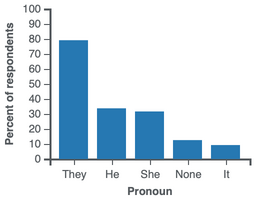 | |
| According to a 2021 survey, the five most popular pronoun sets used by non-binary people are they, he, she, none/avoid pronouns, and it.[61] | |
Some non-binary/genderqueer people use gender-neutral pronouns. In English, usage of singular 'they', 'their' and 'them' is the most common;[61][62] non-standard pronouns – commonly referred to as neopronouns[63] – such as xe, ze, sie, co, and ey are sometimes used as well. Some others use conventional gender-specific pronouns 'he' or 'she', alternately use 'he' and 'she', or use only their name and do not use pronouns at all.[64] Many use additional neutral language, such as the title 'Mx.'[65]
Legal recognition
Many non-binary/genderqueer people use the gender they were given at birth to conduct everyday business, as many institutions and forms of identification – such as passports and driver's licenses – only accept, in the sense of recorded recognition, binary gender identities. However, with the increasing acceptance of non-binary gender identities and the rise in wider societal recognition, this is slowly changing, as a greater number of governments and institutions recognize and allow non-binary identities.[2]
Multiple countries legally recognize non-binary or third gender classifications. Some non-Western societies have long recognized transgender people as a third gender, though this may not (or may only recently)[66] include formal legal recognition. In Western societies, Australia may have been the first country to legally recognize a classification of sex outside of 'male' and 'female' on legal documentation, following the recognition of Alex MacFarlane's intersex status in 2003.[67] The wider legal recognition of non-binary people – following the recognition of intersex people in 2003 – in Australian law followed between 2010 and 2014, with legal action taken against the New South Wales Government Registry of Births, Deaths and Marriages by transgender activist Norrie May-Welby to recognize Norrie's legal gender identity as 'non-specific'. India's Supreme Court formally recognized transgender and non-binary people as a distinct third gender in 2014, following legal action taken by transgender activist Laxmi Narayan Tripathi.[68] In July 2021, Argentina incorporated non-binary gender in its national ID card, becoming the first country in South America to legally recognize non-binary gender on all official documentation; non-binary people in the country will have the option to renew their ID with the letter 'X' under gender.[69][70]
While the United States does not federally recognize a non-binary gender, in 2016 Oregon became the first state to recognize a non-binary gender identity.[71] Following Oregon, in 2017 California passed an act allowing citizens to identify as 'non-binary' on official documents.[71] As of 2019, eight states have passed acts that allow 'non-binary' or 'X' designations on certain identifying documents.[71] One of the main arguments against the inclusion of a third gender identifier in the U.S. is that it would make law enforcement and surveillance harder, however countries that have officially recognized a third gender marker have not reported these issues.[71] In the United States there are no explicit laws to protect non-binary people from discrimination, however it is illegal for an employer to require employees to conform to sex stereotypes.[72]
Discrimination
Various countries throughout history have criminalized transgender and non-binary gender identities.[73][better source needed] In India, hijras and other non-binary identities were criminalized under the Criminal Tribes Act from 1871 onwards, referring to such individuals as "criminal castes."[74]
In the United States, the majority of respondents to the National Transgender Discrimination Survey chose "A gender not listed here". The "not listed here" respondents were nine percentage-points (33 percent) more likely to report forgoing healthcare due to fear of discrimination than the general sample (36 percent compared to 27 percent). Ninety percent reported experiencing anti-trans bias at work, and 43 percent reported having attempted suicide.[75]
The majority of reported discrimination faced by non-binary individuals often includes disregard, disbelief, condescending interactions, and disrespect.[71] People who are non-binary are also often viewed as partaking in part of a trend and are thus deemed insincere or attention-seeking. As an accumulation, erasure is often a large form of discrimination faced by non-binary individuals.[71]
Misgendering is also a problem that many individuals face, be it intentional or unintentional. In the case of intentional misgendering, transphobia is a driving force. Also, the use of they/them pronouns is lumped into the larger, controversial, subject of safe spaces and political correctness,[76] causing push back, and intentional misgendering from some individuals. In the case of unintentional misgendering, it is often expected for the person who is misgendered to console and forgive the person who made the mistake.[77]
Symbols and observances
Many flags have been used in non-binary and genderqueer communities to represent various identities. There are distinct non-binary and genderqueer pride flags. The genderqueer pride flag was designed in 2011 by Marilyn Roxie. Lavender represents androgyny or queerness, white represents agender identity, and green represents those whose identities which are defined outside the binary.[80][81][82] The non-binary pride flag was created in 2014 by Kye Rowan.[83] Yellow represents people whose gender exists outside the binary, purple represents those whose gender is a mixture of – or between – male and female, black represents people who have no gender, and white represents those who embrace many or all genders.[84]
Genderfluid people, who also fall under the genderqueer umbrella, have their own flag as well. Pink represents femininity, white represents lack of gender, purple represents mixed gender or androgyny, black represents all other genders, and blue represents masculinity.[81][85]
Agender people, who also sometimes identify as genderqueer, have their own flag. This flag uses black and white stripes to represent an absence of gender, and a green stripe to represent non-binary genders.[86]
International Non-Binary People's Day is celebrated on 14 July.[87][88][89][90]
Population figures
According to a 2021 study by the Williams Institute, an estimated 1.2 million Americans identify as non-binary, making up 11% of the LGBTQ adult population in the United States.[93]
A 2019 survey of the Two-Spirit and LGBTQ+ population in the Canadian city of Hamilton, Ontario, called Mapping the Void: Two-Spirit and LGBTQ+ Experiences in Hamilton showed that 19% of the 906 respondents identified as non-binary.[94]
A 2017 survey of Canadian LGBT+ people called LGBT+ Realities Survey found that 4% of the 1,897 respondents identified as non-binary transgender and 1% identified as non-binary outside of the transgender umbrella.[95]
According to The Report of the 2015 U.S. Transgender Survey, 35% of the nearly 28,000 transgender respondents to the anonymous online survey identified as non-binary.[96][97]
A 2011 survey conducted by the Equality and Human Rights Commission in the UK found that 0.4% of the 10,039 respondents identified as non-binary. It does not allow inference about the share of non-binary people in the whole population, since the survey sample was not necessarily representative. The purpose of the survey was to test if respondents are willing to answer questions about their transsexual status.[98]:4-5
See also
Notes
References
- ↑ Bergman, S. Bear; Barker, Meg-John (2017). "Non-binary Activism". in Richards, Christina; Bouman, Walter Pierre; Barker, Meg-John. Genderqueer and Non-Binary Genders. Critical and Applied Approaches in Sexuality, Gender and Identity. Palgrave Macmillan. p. 43. ISBN 978-1-137-51052-5.
- ↑ 2.0 2.1 Richards, Christina; Bouman, Walter Pierre; Seal, Leighton; Barker, Meg John; Nieder, Timo O.; T'Sjoen, Guy (2016). "Non-binary or genderqueer genders". International Review of Psychiatry 28 (1): 95–102. doi:10.3109/09540261.2015.1106446. PMID 26753630. https://biblio.ugent.be/publication/7279758. Retrieved 9 June 2019.
- ↑ 3.0 3.1 "Supporting & Caring for Transgender Children". Human Rights Campaign. https://www.aap.org/en-us/Documents/solgbt_resource_transgenderchildren.pdf.
- ↑ "Trans + Gender Identity" (in en-US). https://www.thetrevorproject.org/trvr_support_center/trans-gender-identity/.
- ↑ Beemyn, Brett Genny (2008). "Genderqueer". glbtq: An Encyclopedia of Gay, Lesbian, Bisexual, Transgender, and Queer Culture. Chicago, Illinois: glbtq, Inc.. http://www.glbtq.com/social-sciences/genderqueer.html. Retrieved 3 May 2012.
- ↑ 6.0 6.1 Bosson, Jennifer K.; Vandello, Joseph A.; Buckner, Camille E. (2018). The Psychology of Sex and Gender. Thousand Oaks, California: Sage Publications. p. 54. ISBN 978-1-5063-3134-8. OCLC 1038755742. https://books.google.com/books?id=XStGDwAAQBAJ&pg=PT54. Retrieved 4 August 2019.
- ↑ 7.0 7.1 Whyte, Stephen; Brooks, Robert C.; Torgler, Benno (25 September 2018). "Man, Woman, "Other": Factors Associated with Nonbinary Gender Identification". Archives of Sexual Behavior (Heidelberg, Germany: Springer Science+Business Media) 47 (8): 2397–2406. doi:10.1007/s10508-018-1307-3. PMID 30255409. "2 out of 7479 (0.03 percent) of respondents to the Australian Sex Survey, a 2016 online research survey, self-identified as trigender.".
- ↑ Winter, Claire Ruth (2010). Understanding Transgender Diversity: A Sensible Explanation of Sexual and Gender Identities. Scotts Valley, California: CreateSpace. ISBN 978-1-4563-1490-3. OCLC 703235508.[page needed]
- ↑ "Transgender Glossary of Terms". GLAAD Media Reference Guide. Gay & Lesbian Alliance Against Defamation. http://www.glaad.org/reference/transgender.
- ↑ Stryker, Susan (2008). Transgender History. Berkeley, California: Seal Press. ISBN 978-1-58005-224-5. OCLC 183914566.[page needed]
- ↑ 11.0 11.1 Schorn, Johanna. "Taking the "Sex" out of Transsexual: Representations of Trans Identities in Popular Media". Cologne, Germany: University of Cologne. p. 1. http://www.inter-disciplinary.net/critical-issues/wp-content/uploads/2014/08/schornglpaper.pdf. "The term transgender is an umbrella term "and generally refers to any and all kinds of variation from gender norms and expectations" (Stryker 19). Most often, the term transgender is used for someone who feels that the sex assigned to them at birth does not reflect their own gender identity. They may identify as the gender ‘opposite’ to their assigned gender, or they may feel that their gender identity is fluid, or they may reject all gender categorizations and identify as agender or genderqueer."
- ↑ Hendrie, Theo, ed (2019). X Marks the Spot: An Anthology of Nonbinary Experiences. p. 238. ISBN 978-1-0809-6803-9.
- ↑ Dahir, Mubarak (25 May 1999). "Whose Movement Is It?". The Advocate (San Francisco, California: Here Media): 52.
- ↑ Shaw, Susan; Lee, Janet (April 23, 2014). Women's voices, feminist visions : classic and contemporary readings (Sixth ed.). New York. ISBN 978-0-07-802700-0. OCLC 862041473.
- ↑ Girshick, Lori B. (2008). Transgender Voices: Beyond Women and Men. Hanover, New Hampshire: University Press of New England. ISBN 978-1-58465-645-6. OCLC 183162406.
- ↑ Shaw, Susan M.; Lee, Janet (2015). Women's Voices, Feminist Visions (6 ed.). New York City: McGraw-Hill Education.
- ↑ Walsh, Reuben (December 2010). "More T, vicar? My experiences as a genderqueer person of faith". All God's Children (Lesbian and Gay Christian Movement) 2 (3).
- ↑ "Understanding Non-Binary People: How to Be Respectful and Supportive". July 9, 2016. https://transequality.org/issues/resources/understanding-non-binary-people-how-to-be-respectful-and-supportive.
- ↑ Sheridan, Vanessa (2018). Transgender in the Workplace: The Complete Guide. p. 11. ISBN 978-1440858062.
- ↑ Hope, Sam (2019). Person-Centred Counselling for Trans and Gender Diverse People. London, England: Jessica Kingsley Publishers. p. 218. ISBN 978-1784509378.
- ↑ Vargo, Marc E. (30 November 2011). "A Review of Please select your gender: From the invention of hysteria to the democratizing of transgenderism". Journal of GLBT Family Studies 7 (5): 2 (493). doi:10.1080/1550428X.2011.623982. ISSN 1550-4298. "up to three million U. S. citizens regard themselves as transgender, a term referring to those whose gender identities are at odds with their biological sex. The term is an expansive one, however, and may apply to other individuals as well, from the person whose behavior purposely and dramatically diverges from society's traditional male/female roles to the "agender", "bigender" or "third gender" person whose self-definition lies outside of the male/female binary altogether. In short, those counted under this term constitute a wide array of people who do not conform to, and may actively challenge, conventional gender norms.".
- ↑ Cronn-Mills, Kirstin (2014). "IV. Trans*spectrum. Identities". Transgender Lives: Complex Stories, Complex Voices. Minneapolis, Minnesota: Twenty-First Century Books. p. 24. ISBN 978-1-4677-4796-7. https://books.google.com/books?id=dOUSBAAAQBAJ&pg=PA24. Retrieved 23 October 2014. "Many different individuals fall under what experts call the trans* spectrum, or the trans* umbrella."I'm trans*" and "I'm transgender" are ways these individuals might refer to themselves. But there are distinctions among different trans* identities. [...] Androgynous individuals may not identify with either side of the gender binary. Other individuals consider themselves agender, and they may feel they have no gender at all."
- ↑ "Supporting and Caring for our Gender-Expansive Youth". http://hrc-assets.s3-website-us-east-1.amazonaws.com//files/assets/resources/Gender-expansive-youth-report-final.pdf.
- ↑ "LGBTQ Needs Assessment". April 2013. pp. 52–53. http://encompassnetwork.org.uk/uploads/LGBTQ-Needs-Assesmentabsolutelyfinal.pdf.
- ↑ "Gender alphabet". p. 1. http://www.safehomesma.org/gender_alphabet.pdf.
- ↑ Vargo, Marc E. (2011). "A Review of "Please select your gender: From the invention of hysteria to the democratizing of transgenderism"". Journal of GLBT Family Studies 7 (5): 493–494. doi:10.1080/1550428x.2011.623982.
- ↑ Cronn-Mills, Kirstin (2014). Transgender Lives: Complex Stories, Complex Voices. Twenty-First Century Books. ISBN 978-1-4677-4796-7. https://books.google.com/books?id=dOUSBAAAQBAJ. Retrieved 3 February 2016.
- ↑ Schorn, Johanna (22 February 2016). Taking the "Sex" out of Transsexual: Representations of Trans Identities in Popular Media.
- ↑ Anne Enke, ed (2012). "Note on terms and concepts". Transfeminist Perspectives In and Beyond Transgender and Gender Studies. Temple University Press. pp. 16–20 [18–19]. ISBN 978-1-4399-0748-1.
- ↑ Sojwal, Senti (16 September 2015). "What Does "Agender" Mean? 6 Things To Know About People With Non-Binary Identities". http://www.bustle.com/articles/109255-what-does-agender-mean-6-things-to-know-about-people-with-non-binary-identities.
- ↑ Sparkes, Matthew (February 14, 2014). "Facebook sex changes: which one of 50 genders are you?". The Daily Telegraph. https://www.telegraph.co.uk/technology/facebook/10637968/Facebook-sex-changes-which-one-of-50-genders-are-you.html.
- ↑ "OkCupid expands gender and sexuality options". PBS NewsHour. 17 November 2014. https://www.pbs.org/newshour/rundown/okcupid-expands-gender-sexuality-options/.
- ↑ Edwards, Ruth Dudley (August 17, 2014). "Asexual, bigender, transexual or cis, can't we all just be kind to each other?". The Independent. https://www.independent.ie/opinion/columnists/ruth-dudley-edwards/asexual-bigender-transexual-or-cis-cant-we-all-just-be-kind-to-each-other-30513083.html.
- ↑ Persio, Sofia Lotto (June 16, 2017). "Oregon becomes first state to allow option "X" to end gender binary". Newsweek. https://www.newsweek.com/what-third-gender-x-oregon-and-california-are-breaking-mf-binary-626551. Retrieved December 18, 2019.
- ↑ "Everything you ever wanted to know about being nonbinary". September 28, 2017. https://www.dailydot.com/irl/nonbinary-definition-pronouns/.
- ↑ "Billy Dee Williams: What is gender fluid?". December 2, 2019. https://www.monstersandcritics.com/people/billy-dee-williams-what-is-gender-fluid/.
- ↑ "This is the term for people who aren't exclusively male or female". April 26, 2018. https://www.pinknews.co.uk/2018/04/26/non-binary/.
- ↑ "Sexual orientation and gender identity". https://www.apa.org/helpcenter/sexual-orientation.
- ↑ Clements, K. San Francisco Department of Public Health , 1999
- ↑ "EEOC now gives nonbinary people a way to be counted in workplace". https://thinkprogress.org/eeoc-now-gives-nonbinary-people-a-way-to-be-counted-in-workplace-6cd48e1cc804/.
- ↑ "Accelerating Acceptance 2017". GLAAD. https://www.glaad.org/files/aa/2017_GLAAD_Accelerating_Acceptance.pdf.
- ↑ Bosson, Jennifer K.; Vandello, Joseph A.; Buckner, Camille E. (2018-01-17) (in en). The Psychology of Sex and Gender. SAGE Publications. ISBN 978-1-5063-3134-8. https://books.google.com/books?id=XStGDwAAQBAJ&q=Trigender&pg=PT54.
- ↑ Gibson, Sarah; Fernandez, J. (2018). Gender Diversity and Non-Binary Inclusion in the Workplace: The Essential Guide for Employers. London: Jessica Kingsley Publishers. pp. 25. ISBN 978-1-78450-523-3.
- ↑ 44.0 44.1 Brill, Stephanie; Kenney, Lisa (2016). The Transgender Teen. Berkeley, California: Cleis Press. ISBN 978-1627781749.
- ↑ Ginicola, Misty M.; Smith, Cheri; Filmore, Joel M. (2017-02-10) (in en). Affirmative Counseling with LGBTQI+ People. John Wiley & Sons. pp. 366. ISBN 978-1-119-37549-4. https://books.google.com/books?id=pi8bDgAAQBAJ&q=polygender&pg=PA366.
- ↑ "Queer Undefined". https://www.queerundefined.com/search/pangender.
- ↑ 47.0 47.1 Cronn-Mills, Kirstin (2015). Transgender Lives: Complex Stories, Complex Voices. Minneapolis, Minnesota: Twenty-First Century Books. p. 24. ISBN 978-0-7613-9022-0.
- ↑ McGuire, Peter (9 November 2015). "Beyond the binary: what does it mean to be genderfluid?". The Irish Times. http://www.irishtimes.com/life-and-style/people/beyond-the-binary-what-does-it-mean-to-be-genderfluid-1.2418434.
- ↑ Ferguson, Sian (11 June 2020). "What Does It Mean to Be Gender Fluid?" (in en). https://www.healthline.com/health/gender-fluid.
- ↑ Mardell, Ashley (2016). The ABC's of LGBT+. Coral Gables, Florida: Mango Media Inc.. pp. 96. ISBN 978-1-63353-408-7. https://books.google.com/books?id=R0UzDwAAQBAJ&pg=PT96. Retrieved 14 December 2019.
- ↑ 51.0 51.1 51.2 51.3 Tobia, Jacob (7 November 2018). "InQueery: The History of the Word 'Genderqueer' As We Know It" (in en). Condé Nast. https://www.them.us/story/inqueery-genderqueer.
- ↑ Bornstein, Kate (2013) (in en). Gender Outlaw: On Men, Women and the Rest of Us. Abingdon, England: Routledge. ISBN 978-1-136-60373-0. https://books.google.com/books?id=_VsCl7Ek4N8C&q=All+the+categories+of+transgender+find+a+common+ground+in+that+they+each+break+one+or+more+of+the+rules+of+gender%3A+what+we+have+in+common+is+that+we+are+gender+outlaws%2C+every+one+of+us&pg=PT79. Retrieved 19 October 2020.
- ↑ Wilchins, Riki (14 March 2017). "Get to Know the New Pronouns: They, Theirs, and Them" (in en). https://www.pride.com/identities/2017/3/14/get-know-new-pronouns-they-theirs-and-them.
- ↑ 54.0 54.1 "Genderqueer History". http://genderqueerid.com/gqhistory.
- ↑ Wilchins, Riki (Spring 1995). "A Note from your Editrix". In Your Face (1): 4. http://www.gendertalk.com/pubs/InYourFace1.pdf. Retrieved 18 February 2020.
- ↑ "GenderQueer : voices from beyond the sexual binary". GenderQueer : voices from beyond the sexual binary (1st ed.). New York: Alyson Books. 2002. ISBN 978-1-55583-730-3. OCLC 50389309. https://archive.org/details/isbn_9781555837303.
- ↑ Quart, Alissa (March 16, 2008). "When Girls Will Be Boys" (in en-US). The New York Times. ISSN 0362-4331. https://www.nytimes.com/2008/03/16/magazine/16students-t.html.
- ↑ Writer, them (November 7, 2018). "Do You Know What It Means to Be Genderqueer?" (in en). https://www.them.us/story/inqueery-genderqueer.
- ↑ "About Us – Intersex & Genderqueer Recognition Project (IGRP)" (in en). https://www.intersexrecognition.org/about.
- ↑ O'Hara, Mary Emily (December 16, 2016). "Movement for third gender option 'exploding' in U.S." (in en). https://www.nbcnews.com/feature/nbc-out/movement-third-gender-option-exploding-u-s-n696446.
- ↑ 61.0 61.1 "Gender Census 2021: Worldwide Report". 1 April 2021. https://gendercensus.com/results/2021-worldwide/#pronouns.
- ↑ Hekanaho, Laura (8 December 2020). Generic and Nonbinary Pronouns: Usage, Acceptability and Attitudes (PDF) (PhD). University of Helsinki. p. 221. ISBN 978-9515168313. Archived (PDF) from the original on 7 March 2021. Retrieved 7 March 2021.
- ↑ Marcus, Ezra (2021-04-08). "A Guide to Neopronouns" (in en-US). The New York Times. ISSN 0362-4331. https://www.nytimes.com/2021/04/08/style/neopronouns-nonbinary-explainer.html.
- ↑ Feinberg, Leslie (1996). Transgender Warriors: Making History from Joan of Arc to Dennis Rodman. Boston, Massachusetts: Beacon Press. ISBN 978-0-8070-7940-9. OCLC 33014093. https://archive.org/details/transgenderwarri0000fein.
- ↑ Pearce, Ruth (21 July 2011). "Non-gendered titles see increased recognition". Lesbilicious. http://www.lesbilicious.co.uk/non-gendered-titles-see-increased-recognition/.
- ↑ "Pakistani eunuchs to have distinct gender". BBC News. December 23, 2009. http://news.bbc.co.uk/2/hi/south_asia/8428819.stm.
- ↑ "Newsletter of the Sociology of Sexualities Section of the American Sociological Association". American Sociological Association Sexualities News 6 (1). Summer 2003. http://www.asanet.org/sectionsex/documents/SUMMER03sexnews.pdf. Retrieved 9 December 2013.
- ↑ "In India, Landmark Ruling Recognizes Transgender Citizens" (in en). https://www.npr.org/sections/thetwo-way/2014/04/15/303408581/in-india-landmark-ruling-recognizes-transgender-citizens.
- ↑ "Alberto Fernández pone en marcha el DNI para personas no binarias en un paso más por la igualdad de género" (in Spanish). 21 July 2021. https://www.clarin.com/politica/gobierno-pone-marcha-dni-personas-binarias-paso-igualdad-genero_0_wHMaz8YnA.html.
- ↑ Westfall, Sammy (22 July 2021). "Argentina rolls out gender-neutral ID" (in en). The Washington Post. https://www.washingtonpost.com/world/2021/07/22/argentina-nonbinary-id/.
- ↑ 71.0 71.1 71.2 71.3 71.4 71.5 "They, Them, and Theirs". https://harvardlawreview.org/2019/01/they-them-and-theirs/.
- ↑ Cecka, Dale Margolin; Chamallas, Martha (2016). "Price Waterhouse v. Hopkins, 490 U.S. 228 (1989)" (in en). Feminist Judgments. pp. 341–360. doi:10.1017/cbo9781316411254.020. ISBN 978-1-107-12662-6.
- ↑ Wareham, Jamie. "New Report Shows Where It's Illegal To Be Transgender In 2020" (in en). https://www.forbes.com/sites/jamiewareham/2020/09/30/this-is-where-its-illegal-to-be-transgender-in-2020/.
- ↑ Reddy, Gayatri (2005). With respect to sex : negotiating hijra identity in South India. Chicago: University of Chicago Press. pp. 26–27. ISBN 0-226-70755-5. OCLC 55887296. https://books.google.com/books?id=SyqTnL9jTFoC&pg=PA26.
- ↑ "A Gender Not Listed Here: Genderqueers, Gender Rebels, and OtherWise in the National Transgender Discrimination Survey". http://www.thetaskforce.org/downloads/release_materials/agendernotlistedhere.pdf.
- ↑ Richards, Christina; Bouman, Walter Pierre; Barker, Meg-John (2017) (in en). Genderqueer and Non-Binary Genders. Springer. ISBN 978-1-137-51053-2. https://books.google.com/books?id=qFJDDwAAQBAJ&q=Cf.+S.+Bear+Bergman+&pg=PR5. Retrieved 19 October 2020.
- ↑ "Introducing myself as 'they/them/their' at my workplace" (in en). https://www.pri.org/stories/2016-08-08/so-what-are-your-pronouns.
- ↑ "One Who Fights For an Other". The New Indian Express. http://www.newindianexpress.com/education/edex/One-Who-Fights-For-an-Other/2015/04/13/article2756559.ece.
- ↑ "Worldwide gay rights as a social movement picks up". merinews.com. http://www.merinews.com/article/worldwide-gay-rights-as-a-social-movement-picks-up/15914647.shtml.
- ↑ Deater, Lynn (April 29, 2015). "He, She or They? » The Commuter". http://ncccommuter.org/he-she-or-they/.
- ↑ 81.0 81.1 "Flags and Symbols". Amherst, Massachusetts: Amherst University. https://www.amherst.edu/system/files/Flags%2520and%2520Symbols.pdf.
- ↑ "Gender and Sexuality Awareness Flags" (in en-US). David Mariner. 2015-10-26. http://www.davidmariner.com/flags/.
- ↑ "8 Things Non-Binary People Need to Know". 2015-03-15. https://letsqueerthingsup.com/2015/03/15/8-things-non-binary-people-need-to-know/.
- ↑ "After counting up all the 'votes' for each variation of my nonbinary flag (to be separate from the genderqueer flag), it seems this is the most loved! Yay!". Tumblr. http://thejasmineelf.tumblr.com/post/77007286542/after-counting-up-all-the-votes-for-each.
- ↑ "Gender-fluid added to the Oxford English Dictionary". LGBTQ Nation. http://www.lgbtqnation.com/2016/09/gender-fluid-added-oxford-english-dictionary/.
- ↑ Manzella, Samantha (2017-10-07). "Beyond The Rainbow: Your Guide To LGBT Flags". NewNowNext. http://www.newnownext.com/guide-lgbt-flags/07/2017/.
- ↑ Mathers, Charlie (2018-07-13). "Prepare for International Non-binary Day by learning how to be a better ally". https://www.gaystarnews.com/article/non-binary-day-allies/.
- ↑ Hirst, Jordan (2018-07-10). "Inclusive Brisbane Party To Mark International Non-Binary Day". https://www.qnews.com.au/inclusive-brisbane-party-to-celebrate-international-non-binary-day/.
- ↑ "Important LGBT Dates". White Plains, NY. http://www.lgbtlifewestchester.org/important_lgbt_dates.
- ↑ "International Non-Binary People's Day" (in en-AU). acon. http://www.prideinclusionprograms.com.au/event/international-non-binary-peoples-day/.
- ↑ Gray, Emma; Vagianos, Alanna (July 27, 2017). "We Have A Navy Veteran To Thank For The Transgender Pride Flag". Huffington Post. https://www.huffingtonpost.com.au/entry/we-have-a-navy-veteran-to-thank-for-the-transgender-pride-flag_us_5978c060e4b0e201d57a711f.
- ↑ LB, Branson (July 26, 2017). "The Veteran Who Created The Trans Pride Flag Reacts To Trump's Trans Military Ban". Buzzfeed. https://www.buzzfeednews.com/article/bransonlb/the-veteran-who-created-the-trans-pride-flag-reacts-to.
- ↑ Wilson, Bianca D.M.; Meyer, Ilan H. (June 2021). "Nonbinary LGBTQ Adults in the United States". Williams Institute. https://williamsinstitute.law.ucla.edu/publications/nonbinary-lgbtq-adults-us/.
- ↑ "Mapping the Void: Two-Spirit and LGBTQ+ Experiences in Hamilton". 11 Jun 2019. https://labourstudies.mcmaster.ca/documents/mappingthevoid.pdf.
- ↑ "The values, needs and realities of LGBT people in Canada in 2017". 2017. https://fondationjasminroy.com/en/initiative/lgbt-realities-survey/.
- ↑ Cummings, William (June 21, 2017). "When asked their sex, some are going with option 'X'" (in en-US). USA Today. https://www.usatoday.com/story/news/2017/06/21/third-gender-option-non-binary/359260001/.
- ↑ "The Report of the 2015 U.S. Transgender Survey". National Center for Transgender Equality. 2016. p. 45. http://www.transequality.org/sites/default/files/docs/usts/USTS%20Full%20Report%20-%20FINAL%201.6.17.pdf.
- ↑ Glen, Fiona; Hurrell, Karen (2012). "Technical note: Measuring Gender Identity". Equality and Human Rights Commission. https://www.equalityhumanrights.com/sites/default/files/technical_note_final.pdf.
Further reading
- Barker, Meg-John; Scheele, Julia. (2016). Queer: A Graphic History. London: Icon Books. ISBN:978-1-78578-071-4. OCLC 939427299.
- Bernstein Sycamore, Mattilda, ed (2006). Nobody Passes: Rejecting the Rules of Gender and Conformity. Emeryville: Seal Press. ISBN 978-1-58005-184-2. OCLC 50389309.
- Bornstein, Kate; Bergman, S. Bear, eds (2010). Gender Outlaws: The Next Generation (Reprint ed.). Berkeley: Seal Press. ISBN 978-1-58005-308-2. OCLC 837948378. https://archive.org/details/genderoutlawsnex00born_0.
- Fine, Cordelia (2011). Delusions of Gender: How Our Minds, Society, and Neurosexism Create Difference (Reprint ed.). New York: W. W. Norton & Company. ISBN 978-0-393-34024-2. OCLC 449865367.
- Fineman, Martha Albertson (2013). "Feminism, masculinities, and multiple identities". Nevada Law Journal 13 (2): 16. http://scholars.law.unlv.edu/nlj/vol13/iss2/16.
- Hines, Melissa (2005). Brain Gender. Oxford University Press. ISBN 978-0-19-518836-3. OCLC 846105995.
- Nestle, Joan; Howell, Clare; Wilchins, Riki Anne, eds (2002). GenderQueer: Voices from Beyond the Sexual Binary. Los Angeles: Alyson Books. ISBN 978-1-55583-730-3. OCLC 50389309. https://archive.org/details/isbn_9781555837303.
- Peterson, Tim Trace; Tolbert, T. C., eds (2013). Troubling the Line: Trans and Genderqueer Poetry and Poetics. Callicoon: Nightboat Books. ISBN 978-1-937658-10-6. OCLC 839307399.
- Richards, C., Bouman, W. P., & Barker, M.-J. (2017). Genderqueer and non-binary genders. London: Palgrave Macmillan. ISBN:978-1-137-51052-5. OCLC 1021393997.
- Scout, Ph.D. (23 July 2013). "(A) Male, (B) Female, (C) Both, (D) Neither". AOL. http://www.huffingtonpost.com/scout-phd/a-male-b-female-c-both-d-neither_b_2887462.html.
- Stryker, Susan; Whittle, Stephen, eds (2006). The Transgender Studies Reader. New York]: Routledge. ISBN 978-1-58005-184-2. OCLC 50389309.
